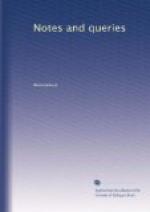“I, Myles Blomefylde, of Burye Saynct Edmunde in Suffolke, was borne ye yeare following after ye pryntyng of this boke (that is to saye) in the yeare of our Lorde 1525, the 5 day of Apryll, betwene 10 & 11, in ye nyght, nyghest xi, my father’s name John, and my mother’s name Anne.”
This tract is bound up with two others, on both of which Blomefylde has written his initials, and from one entry seems to have been at Venice in 1568. He was undoubtedly an ardent book-collector, and I possess copies of the Ortus Vocabulorum, printed by W. de Worde, in 1518, and the Promptuarium Parvulorum, printed by the same, in 1516, bound together, on both of which the name of Myles Blomefylde in inscribed.
I may add, as a slight contribution to a future edition of the Typographical Antiquities, that among Bagford’s curious collection of title-pages in the Harleian Collection of MSS. (which I doubt if Dr. Dibdin ever consulted with care), there is the last leaf of an edition of the Ortus Vocabulorum, unnoticed by bibliographers, with the following colophon:—
“Impr. London. per Wynandum de Worde, commorantem in vico nuncupato Fletestrete, sub intersignio solis aurei, Anno incarnatiois Dominice M.CCCCC.IX. die vero prima mesis Decebris.”—Harl. MSS. 5919. art. 36.
* * * * *
ANSWERS TO MINOR QUERIES.
The Curse of Scotland—Why the Nine of Diamonds is so called.
When I was a child (now about half a century ago) my father used to explain the origin of the nine of diamonds being called “The curse of Scotland” thus: That it was the “cross of Scotland,” which, in the Scotch pronunciation, had become “curse.”
St. Andrew is the patron saint of Scotland: he suffered on a cross, not of the usual form, but like the letter X, which has since been commonly called a St. Andrew’s cross. It was supposed that the similarity of the nine of diamonds to this form occasioned its being so called. The arms of the Earl of Stair, alluded to in your publication, are exactly in the form of this cross. If this explanation should be useful, you are most welcome to it.
A.F.
Thistle of Scotland.
Sir,—Your correspondent R.L. (No. 2. p. 24.), will find the fullest information on this head in Sir Harris Nicolas’s work on the Orders of Knighthood of the British Empire. He does not assign to its origin an earlier date than the reign of James III, in an inventory of whose jewels, Thistles are mentioned as part of the ornaments. The motto “Nemo me impune lacessit,” does not appear until James VI. adopted it on his coinage.
G.H.B.
For Scottish Thistle, see Nisbet’s Heraldry, vol. ii. Order of St. Andrew. Selden, Titles of Honour, p. 704. ed. 1672, refers to “Menenius, Miraeus, Favin, and such more.”




